Behrooz Ghorbani
Tony
OpenAI o1 System Card
Dec 21, 2024



Abstract:The o1 model series is trained with large-scale reinforcement learning to reason using chain of thought. These advanced reasoning capabilities provide new avenues for improving the safety and robustness of our models. In particular, our models can reason about our safety policies in context when responding to potentially unsafe prompts, through deliberative alignment. This leads to state-of-the-art performance on certain benchmarks for risks such as generating illicit advice, choosing stereotyped responses, and succumbing to known jailbreaks. Training models to incorporate a chain of thought before answering has the potential to unlock substantial benefits, while also increasing potential risks that stem from heightened intelligence. Our results underscore the need for building robust alignment methods, extensively stress-testing their efficacy, and maintaining meticulous risk management protocols. This report outlines the safety work carried out for the OpenAI o1 and OpenAI o1-mini models, including safety evaluations, external red teaming, and Preparedness Framework evaluations.
GPT-4o System Card
Oct 25, 2024Abstract:GPT-4o is an autoregressive omni model that accepts as input any combination of text, audio, image, and video, and generates any combination of text, audio, and image outputs. It's trained end-to-end across text, vision, and audio, meaning all inputs and outputs are processed by the same neural network. GPT-4o can respond to audio inputs in as little as 232 milliseconds, with an average of 320 milliseconds, which is similar to human response time in conversation. It matches GPT-4 Turbo performance on text in English and code, with significant improvement on text in non-English languages, while also being much faster and 50\% cheaper in the API. GPT-4o is especially better at vision and audio understanding compared to existing models. In line with our commitment to building AI safely and consistent with our voluntary commitments to the White House, we are sharing the GPT-4o System Card, which includes our Preparedness Framework evaluations. In this System Card, we provide a detailed look at GPT-4o's capabilities, limitations, and safety evaluations across multiple categories, focusing on speech-to-speech while also evaluating text and image capabilities, and measures we've implemented to ensure the model is safe and aligned. We also include third-party assessments on dangerous capabilities, as well as discussion of potential societal impacts of GPT-4o's text and vision capabilities.
Order Matters in the Presence of Dataset Imbalance for Multilingual Learning
Dec 11, 2023Abstract:In this paper, we empirically study the optimization dynamics of multi-task learning, particularly focusing on those that govern a collection of tasks with significant data imbalance. We present a simple yet effective method of pre-training on high-resource tasks, followed by fine-tuning on a mixture of high/low-resource tasks. We provide a thorough empirical study and analysis of this method's benefits showing that it achieves consistent improvements relative to the performance trade-off profile of standard static weighting. We analyze under what data regimes this method is applicable and show its improvements empirically in neural machine translation (NMT) and multi-lingual language modeling.
Epsilon Sampling Rocks: Investigating Sampling Strategies for Minimum Bayes Risk Decoding for Machine Translation
May 18, 2023



Abstract:Recent advances in machine translation (MT) have shown that Minimum Bayes Risk (MBR) decoding can be a powerful alternative to beam search decoding, especially when combined with neural-based utility functions. However, the performance of MBR decoding depends heavily on how and how many candidates are sampled from the model. In this paper, we explore how different sampling approaches for generating candidate lists for MBR decoding affect performance. We evaluate popular sampling approaches, such as ancestral, nucleus, and top-k sampling. Based on our insights into their limitations, we experiment with the recently proposed epsilon-sampling approach, which prunes away all tokens with a probability smaller than epsilon, ensuring that each token in a sample receives a fair probability mass. Through extensive human evaluations, we demonstrate that MBR decoding based on epsilon-sampling significantly outperforms not only beam search decoding, but also MBR decoding with all other tested sampling methods across four language pairs.
Scaling Laws for Multilingual Neural Machine Translation
Feb 19, 2023



Abstract:In this work, we provide a large-scale empirical study of the scaling properties of multilingual neural machine translation models. We examine how increases in the model size affect the model performance and investigate the role of the training mixture composition on the scaling behavior. We find that changing the weightings of the individual language pairs in the training mixture only affect the multiplicative factor of the scaling law. In particular, we observe that multilingual models trained using different mixing rates all exhibit the same scaling exponent. Through a novel joint scaling law formulation, we compute the effective number of parameters allocated to each language pair and examine the role of language similarity in the scaling behavior of our models. We find little evidence that language similarity has any impact. In contrast, the direction of the multilinguality plays a significant role, with models translating from multiple languages into English having a larger number of effective parameters per task than their reversed counterparts. Finally, we leverage our observations to predict the performance of multilingual models trained with any language weighting at any scale, significantly reducing efforts required for language balancing in large multilingual models. Our findings apply to both in-domain and out-of-domain test sets and to multiple evaluation metrics, such as ChrF and BLEURT.
Binarized Neural Machine Translation
Feb 09, 2023Abstract:The rapid scaling of language models is motivating research using low-bitwidth quantization. In this work, we propose a novel binarization technique for Transformers applied to machine translation (BMT), the first of its kind. We identify and address the problem of inflated dot-product variance when using one-bit weights and activations. Specifically, BMT leverages additional LayerNorms and residual connections to improve binarization quality. Experiments on the WMT dataset show that a one-bit weight-only Transformer can achieve the same quality as a float one, while being 16x smaller in size. One-bit activations incur varying degrees of quality drop, but mitigated by the proposed architectural changes. We further conduct a scaling law study using production-scale translation datasets, which shows that one-bit weight Transformers scale and generalize well in both in-domain and out-of-domain settings. Implementation in JAX/Flax will be open sourced.
Do Current Multi-Task Optimization Methods in Deep Learning Even Help?
Sep 23, 2022

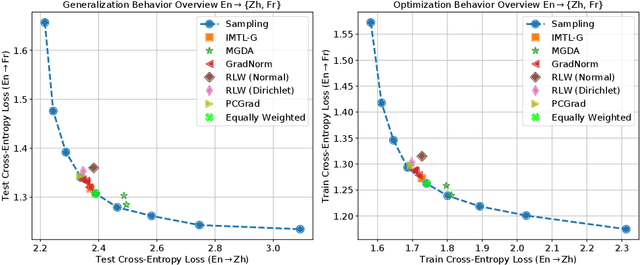

Abstract:Recent research has proposed a series of specialized optimization algorithms for deep multi-task models. It is often claimed that these multi-task optimization (MTO) methods yield solutions that are superior to the ones found by simply optimizing a weighted average of the task losses. In this paper, we perform large-scale experiments on a variety of language and vision tasks to examine the empirical validity of these claims. We show that, despite the added design and computational complexity of these algorithms, MTO methods do not yield any performance improvements beyond what is achievable via traditional optimization approaches. We highlight alternative strategies that consistently yield improvements to the performance profile and point out common training pitfalls that might cause suboptimal results. Finally, we outline challenges in reliably evaluating the performance of MTO algorithms and discuss potential solutions.
Adaptive Gradient Methods at the Edge of Stability
Jul 29, 2022
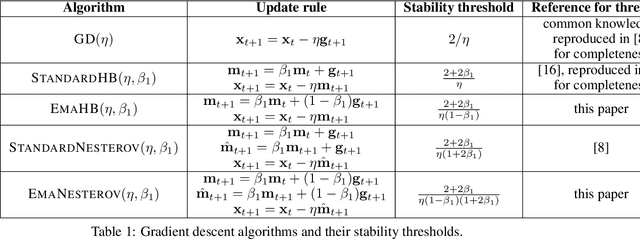
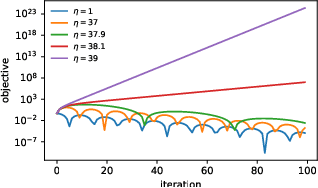

Abstract:Very little is known about the training dynamics of adaptive gradient methods like Adam in deep learning. In this paper, we shed light on the behavior of these algorithms in the full-batch and sufficiently large batch settings. Specifically, we empirically demonstrate that during full-batch training, the maximum eigenvalue of the preconditioned Hessian typically equilibrates at a certain numerical value -- the stability threshold of a gradient descent algorithm. For Adam with step size $\eta$ and $\beta_1 = 0.9$, this stability threshold is $38/\eta$. Similar effects occur during minibatch training, especially as the batch size grows. Yet, even though adaptive methods train at the ``Adaptive Edge of Stability'' (AEoS), their behavior in this regime differs in a significant way from that of non-adaptive methods at the EoS. Whereas non-adaptive algorithms at the EoS are blocked from entering high-curvature regions of the loss landscape, adaptive gradient methods at the AEoS can keep advancing into high-curvature regions, while adapting the preconditioner to compensate. Our findings can serve as a foundation for the community's future understanding of adaptive gradient methods in deep learning.
Examining Scaling and Transfer of Language Model Architectures for Machine Translation
Feb 16, 2022



Abstract:Natural language understanding and generation models follow one of the two dominant architectural paradigms: language models (LMs) that process concatenated sequences in a single stack of layers, and encoder-decoder models (EncDec) that utilize separate layer stacks for input and output processing. In machine translation, EncDec has long been the favoured approach, but with few studies investigating the performance of LMs. In this work, we thoroughly examine the role of several architectural design choices on the performance of LMs on bilingual, (massively) multilingual and zero-shot translation tasks, under systematic variations of data conditions and model sizes. Our results show that: (i) Different LMs have different scaling properties, where architectural differences often have a significant impact on model performance at small scales, but the performance gap narrows as the number of parameters increases, (ii) Several design choices, including causal masking and language-modeling objectives for the source sequence, have detrimental effects on translation quality, and (iii) When paired with full-visible masking for source sequences, LMs could perform on par with EncDec on supervised bilingual and multilingual translation tasks, and improve greatly on zero-shot directions by facilitating the reduction of off-target translations.
Data Scaling Laws in NMT: The Effect of Noise and Architecture
Feb 04, 2022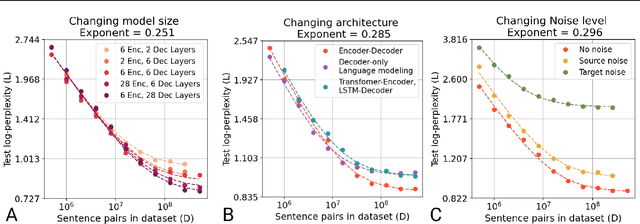


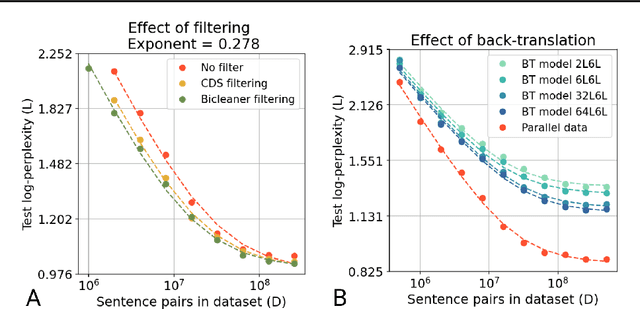
Abstract:In this work, we study the effect of varying the architecture and training data quality on the data scaling properties of Neural Machine Translation (NMT). First, we establish that the test loss of encoder-decoder transformer models scales as a power law in the number of training samples, with a dependence on the model size. Then, we systematically vary aspects of the training setup to understand how they impact the data scaling laws. In particular, we change the following (1) Architecture and task setup: We compare to a transformer-LSTM hybrid, and a decoder-only transformer with a language modeling loss (2) Noise level in the training distribution: We experiment with filtering, and adding iid synthetic noise. In all the above cases, we find that the data scaling exponents are minimally impacted, suggesting that marginally worse architectures or training data can be compensated for by adding more data. Lastly, we find that using back-translated data instead of parallel data, can significantly degrade the scaling exponent.
 Add to Chrome
Add to Chrome Add to Firefox
Add to Firefox Add to Edge
Add to Edge